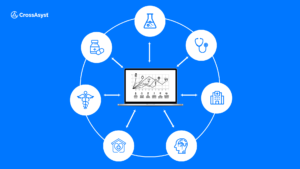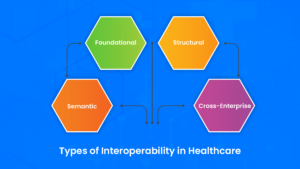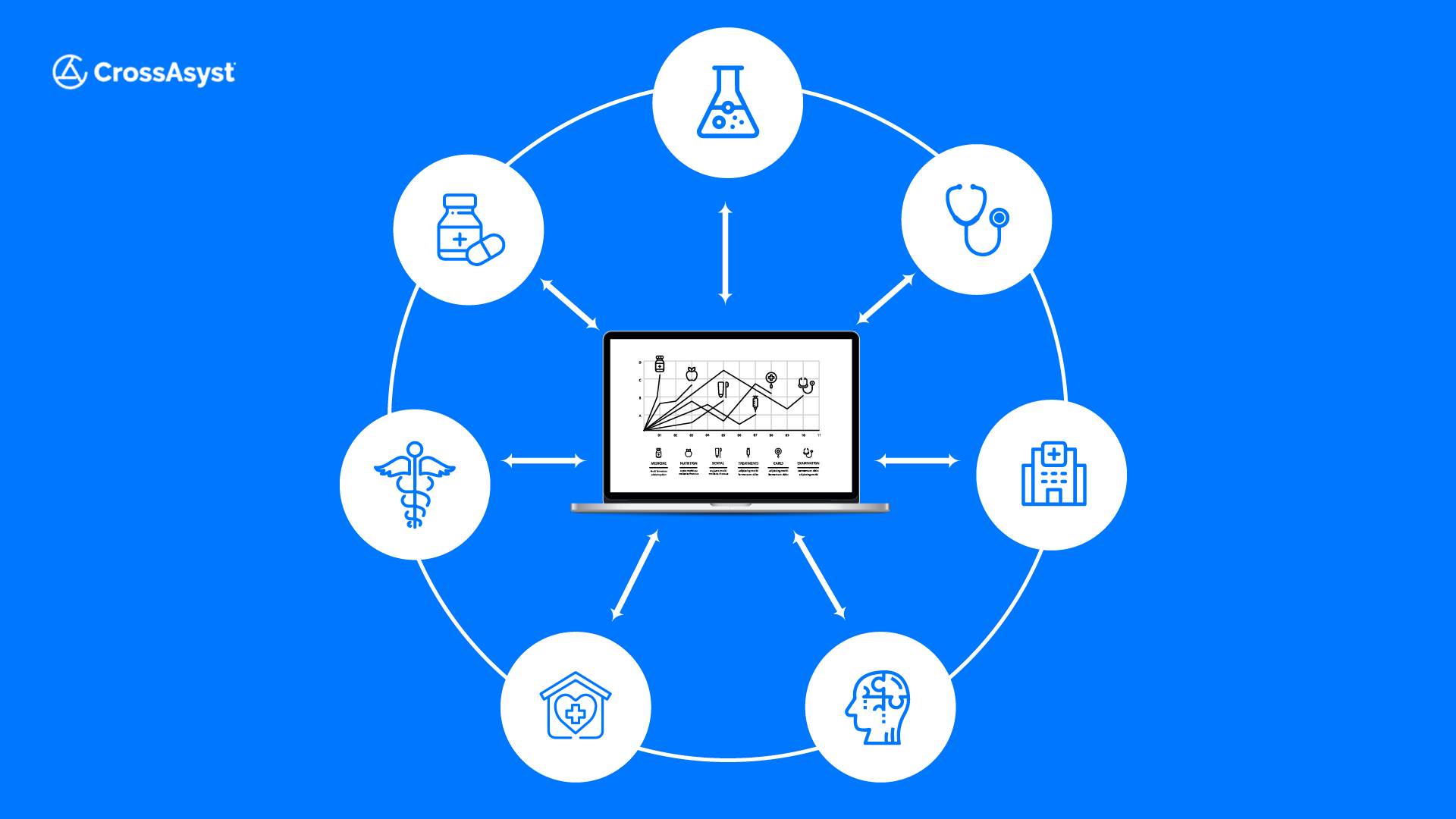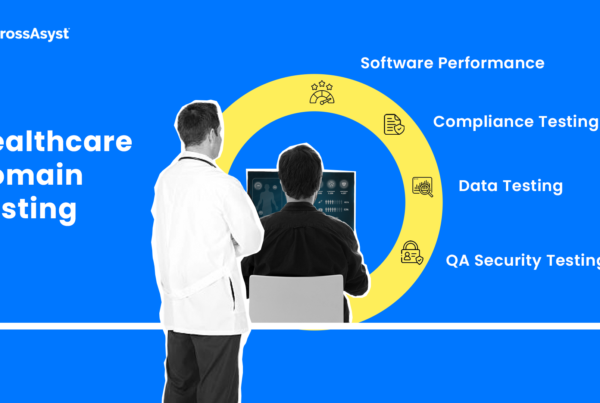
Technology is now an inseparable part of our lives, and that holds true for businesses as well. In fact, many businesses require multiple technological devices to work harmoniously with each other for them to function effectively.
Making these separate technological devices work seamlessly with each other is broadly what interoperability is. As the healthcare industry quickly adapts to newer technologies to increase efficiency and offer better patient outcomes, interoperability of healthcare technology has become essential.
So much so that HIPAA supports interoperability, and that interoperability in healthcare as an industry is projected to grow at a CAGR of 11.31%, from $4.07 billion in 2023 to $6.96 billion by 2028.
Table of Contents
What is Interoperability in Healthcare?
Interoperability in healthcare refers to the ability of different healthcare systems, software, and devices to seamlessly exchange and use patient information and data. It involves the sharing of medical records, test results, treatment plans, and other relevant health information among various healthcare entities, such as hospitals, clinics, pharmacies, and laboratories.
This exchange of data ensures that healthcare providers have access to comprehensive patient information, leading to better-informed decisions and improved patient outcomes.
What Are the Types of Interoperability in Healthcare?

Interoperability in healthcare takes on various forms, each playing a crucial role in facilitating seamless data exchange and collaboration within the complex healthcare ecosystem. These types of interoperability are essential for ensuring that patient information flows efficiently and securely between different healthcare entities:
Foundational Interoperability
This type focuses on the basic exchange of data between different systems without interpreting the meaning of the data. It involves the transmission of data in a consistent format, allowing systems to recognize and receive the information.
Structural Interoperability
Structural interoperability ensures that the data exchanged between systems follows a standardized format and structure. It defines the way data elements are organized and how they relate to each other. This standardization allows different systems to accurately interpret and process the data.
Semantic Interoperability
The highest level of interoperability, semantic interoperability, goes beyond data exchange and ensures that the meaning and context of the data are preserved. It involves the use of common terminology, codes, and definitions to enable a shared understanding of patient information among healthcare providers.
Cross-Enterprise Interoperability
This type of interoperability enables data exchange and collaboration across different healthcare organizations, such as hospitals, clinics, laboratories, and pharmacies. It ensures that patient information can be securely shared between disparate entities for comprehensive care.
Why is Interoperability Important in Healthcare?
Here are some of the most compelling reasons why interoperability is important in healthcare.
Aiding Clinical Decisions
Interoperability empowers healthcare professionals with a holistic view of a patient’s medical history, enabling them to make more informed clinical decisions.
With access to complete and up-to-date information, doctors can better diagnose conditions, prescribe appropriate treatments, and avoid adverse drug interactions.
Improving Patient Engagement & Patient Information
Interoperability enhances patient engagement by providing individuals with easy access to their own health records. Patients can review their medical history, test results, and treatment plans, allowing them to actively participate in their healthcare decisions. This transparency fosters a sense of empowerment and trust between patients and healthcare providers.
Maximizing ROI on Tech Investments
Healthcare institutions invest significant resources in implementing electronic health records (EHRs) and other technology solutions. Interoperability ensures that these investments are maximized by allowing systems to work together efficiently. It reduces redundancy, minimizes data entry errors, and increases the overall efficiency of healthcare operations.
Enabling Innovation and Research
Interoperability creates a fertile ground for healthcare innovation and research. By aggregating data from various sources, researchers can analyze large datasets to identify trends, patterns, and potential breakthroughs. This accelerates medical research and the development of new treatments and therapies.
Benefits of Interoperability in Healthcare
Let’s now take a quick look at the many benefits that interoperability brings to healthcare.
Reduces Errors and Improves Efficiency
Interoperability minimizes errors caused by manual data entry and incomplete patient information. This leads to safer and more efficient healthcare delivery, reducing the likelihood of misdiagnosis, duplicate tests, and medication errors.
Enhanced Patient Care
Seamless data sharing ensures that healthcare providers have a comprehensive understanding of a patient’s health history, leading to more personalized and effective care. It also facilitates care coordination among different providers, ensuring that patients receive the right care at the right time.
Efficiency and Cost Savings
Interoperability streamlines administrative processes, such as billing and insurance claims. By automating these tasks and reducing paperwork, healthcare institutions can cut operational costs and allocate resources more effectively.
Improved Public Health
Interoperability contributes to the early detection and management of public health issues, such as disease outbreaks and epidemics. Timely access to data allows health authorities to respond swiftly, minimizing the spread of diseases.
Data Accuracy and Trend Analysis
Accurate and comprehensive data is invaluable for tracking healthcare trends and making informed policy decisions. Interoperability ensures data accuracy and enables health organizations to monitor population health and identify areas for improvement.
Creating a Connected Health Ecosystem
Interoperability fosters collaboration among healthcare providers, payers, and patients. It promotes a connected health ecosystem where information flows seamlessly, supporting preventive care and better health outcomes.
Remote Monitoring and Telehealth
Interoperability plays a pivotal role in remote patient monitoring and telehealth. It enables the transmission of real-time patient data to healthcare providers, making it possible to monitor patients with chronic conditions and provide remote consultations.
Interdisciplinary Collaboration
In a healthcare landscape where multiple specialists may be involved in a patient’s care, interoperability facilitates interdisciplinary collaboration. It ensures that all healthcare professionals have access to the same patient data, leading to more coordinated and effective care.
What Does Interoperability Mean for Compact Healthcare Clinics?
Interoperability is often viewed as a concept that primarily benefits large healthcare institutions with extensive resources and infrastructure. However, it’s crucial to recognize that compact healthcare clinics, including small private practices and community health centers, can reap significant advantages from adopting interoperable systems.
Here’s a closer look at how interoperability can make a substantial difference for these smaller healthcare providers:
Improved Patient Care
Compact healthcare clinics can enhance the quality of care they offer by seamlessly accessing and sharing patient data with other healthcare entities. For instance, a small clinic may need to refer a patient to a specialist or a larger hospital.
With interoperable systems in place, they can swiftly transmit the patient’s medical history, test results, and treatment plans, ensuring a smooth transition of care. This not only benefits patients by expediting their care but also bolsters the clinic’s reputation for providing thorough and coordinated services.
Streamlined Operations
Interoperability eliminates the need for manual data entry and paperwork, reducing administrative overhead for compact clinics.
This streamlining of operations means that staff can spend more time on patient care and less on paperwork, ultimately leading to improved efficiency and productivity. The reduced administrative burden can also translate into cost savings over time.
Enhanced Collaboration
Collaboration is key in healthcare, regardless of the size of the institution. Interoperability allows compact healthcare clinics to collaborate more effectively with other providers, such as pharmacies, laboratories, and imaging centers.
This enables seamless sharing of information like prescriptions, test results, and diagnostic images, ensuring that the patient’s care journey is well-coordinated. Additionally, interoperable systems make it easier for smaller clinics to participate in care networks and referral networks, expanding their reach and patient base.
Data-Driven Decision Making
Interoperability provides compact clinics with access to a larger pool of patient data. This data can be invaluable for identifying trends, assessing treatment outcomes, and making informed decisions about patient care.
Smaller clinics can harness this data to refine their treatment protocols and enhance patient outcomes. Additionally, access to comprehensive patient data can aid in preventive care and early intervention, reducing the long-term healthcare costs for both patients and the clinic.
Compliance with Regulatory Requirements
Regulatory bodies and healthcare authorities are emphasizing the importance of interoperability. For compact clinics, adhering to these standards ensures compliance with healthcare regulations such as HIPAA, which is essential for maintaining licensure and accreditation.
Furthermore, it can simplify the reporting requirements for quality measures and outcomes, which are increasingly tied to reimbursement in healthcare.
Challenges of Interoperability in Healthcare
While interoperability in healthcare holds immense promise, it is accompanied by several formidable challenges that must be addressed to realize its full potential. Here are some of the key hurdles.
Coordination Deficiency
Achieving interoperability requires seamless coordination among various stakeholders, including healthcare providers, technology vendors, government agencies, and regulatory bodies. The lack of a unified approach and collaboration can hinder progress.
Smaller healthcare providers may face difficulties in navigating the complex web of stakeholders and ensuring that everyone is aligned towards the interoperability goals.
Financial Limitations
The implementation of interoperable systems often entails substantial upfront costs, ranging from purchasing compatible technology to staff training and system integration.
Smaller healthcare organizations, particularly those with limited financial resources, may struggle to make these investments. They may need to seek financial assistance or grants to bridge the financial gap and move forward with interoperability initiatives.
Diverse Technological Requirements
Healthcare systems use a diverse range of technologies and data standards. This heterogeneity can make it challenging to ensure seamless data exchange. Smaller clinics, in particular, may rely on different EHR systems or have limited IT capabilities.
Overcoming these technological disparities requires careful planning, standardization efforts, and the adoption of interoperable technologies that can bridge these gaps effectively.
Legacy System Challenges
Many healthcare organizations, including compact clinics, still operate legacy systems that were not designed with interoperability in mind. Integrating these outdated systems into a modern interoperable environment can be a complex and resource-intensive task.
Compact clinics may need to assess the feasibility of transitioning from legacy systems to more interoperable solutions and weigh the potential benefits against the challenges involved.
Best Practices: Interoperability in Healthcare
Here are some industry best practices that leading healthcare organizations follow when it comes to interoperability.

1. Standardization Initiatives
Health Level 7 (HL7) and Fast Healthcare Interoperability Resources (FHIR) are two prominent standards that play a pivotal role in interoperability.
HL7 is a widely recognized standard for healthcare data exchange. It defines a framework for the exchange, integration, sharing, and retrieval of electronic health information.
FHIR is a modern standard developed to make healthcare data more accessible, structured, and easily exchanged. It utilizes resources and application programming interfaces (APIs) to enable data sharing.
Advantages of Standardization
Standardization in healthcare interoperability offers several advantages:
- It ensures that data is structured and formatted consistently across various systems and institutions, reducing the risk of data misinterpretation.
- Standardized data formats simplify integration and reduce the complexity of implementing interoperable solutions.
- Standardization facilitates the scalability of healthcare systems, making it easier to adapt to evolving healthcare needs and technologies.
- It fosters the development of a broader healthcare ecosystem where different applications and systems can seamlessly interact.
2. Technology Solutions
Here’s a quick look at the technology that drives healthcare interoperability.
-
Integration Platforms and Middleware
Integration platforms and middleware act as the glue that binds different systems and applications together. They enable data to flow seamlessly from one system to another, ensuring that healthcare data can be accessed when and where it’s needed.
-
Data Normalization Techniques
Data normalization involves transforming data into a consistent format, ensuring that it conforms to predefined standards. This process simplifies data exchange and reduces discrepancies between systems. Techniques like data mapping, terminology mapping, and data transformation are essential for achieving data normalization.
3. Data Governance and Quality
-
Data Cleansing and Validation
Data quality is paramount in healthcare. To maintain high data quality, healthcare organizations should implement data cleansing and validation processes.
This involves identifying and rectifying errors, inconsistencies, and inaccuracies in healthcare data. Validating data at the point of entry ensures that only accurate information enters the system.
-
Data Stewardship Programs
Data stewardship involves assigning responsibilities for data management and ensuring data quality throughout its lifecycle. Creating data stewardship programs helps maintain data integrity, privacy, and security.
Stewards oversee data collection, usage, and access, promoting responsible data handling within the organization.
4. Interoperability Roadmaps
-
Setting Clear Goals and Timelines
Successful interoperability requires a well-defined roadmap with clear objectives and timelines. Establishing specific, measurable, achievable, relevant, and time-bound (SMART) goals helps guide the implementation process.
-
Collaboration Among Healthcare Stakeholders
Interoperability cannot be achieved in isolation. Collaboration among various stakeholders, including healthcare providers, payers, technology vendors, and regulatory bodies, is essential. Coordination ensures that all parties are aligned with interoperability goals and work together to overcome challenges.
5. Data Security Measures
Ensuring the security of healthcare data is paramount. Implementing robust security measures, such as encryption, access controls, and audit trails, helps protect patient information during exchange and storage. Compliance with healthcare data privacy regulations, like HIPAA in the United States, is critical.
6. Education and Training
-
Training Healthcare Professionals in Interoperability
Healthcare professionals need to be educated about interoperability concepts and how to use interoperable systems effectively. Training programs should cover data exchange protocols, standards, and the importance of data sharing for patient care.
-
Creating a Culture of Data Sharing
Fostering a culture of data sharing within healthcare organizations is essential. This involves promoting a mindset where data is seen as a valuable resource that, when shared responsibly, can lead to improved patient outcomes. Leadership and communication play vital roles in cultivating this culture.
Ensure Seamless Healthcare Operations With Crossasyst
With over a decade of experience in building custom healthcare software solutions, we at CrossAsyst understand the importance of interoperability and integration between multiple tools to ensure seamless operations in a healthcare organization.
Our team of experts will ensure all your systems interact with each other flawlessly and exchange data efficiently, enabling you to make the best use of the data at your disposal. Contact our team today to leverage our interoperability expertise and ensure data communications between all your systems are always seamless, efficient and glitch free.





